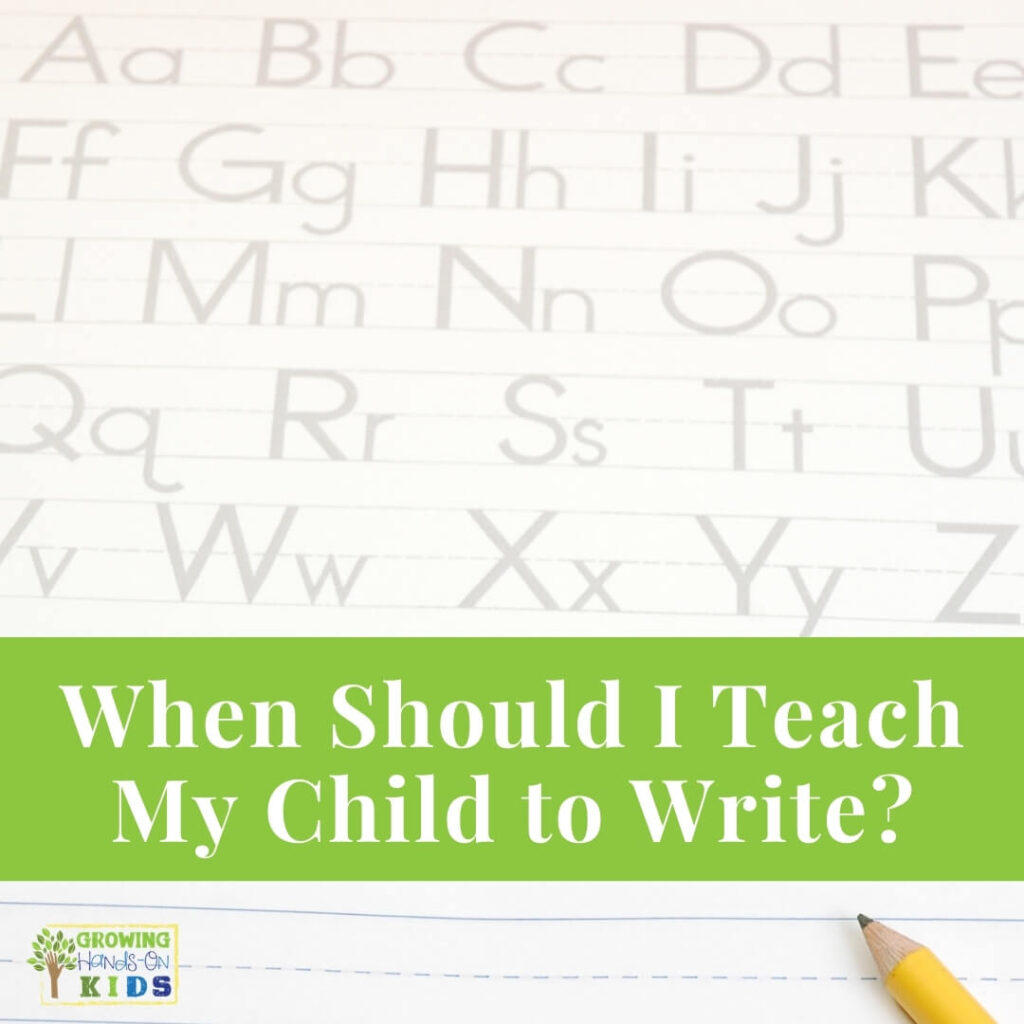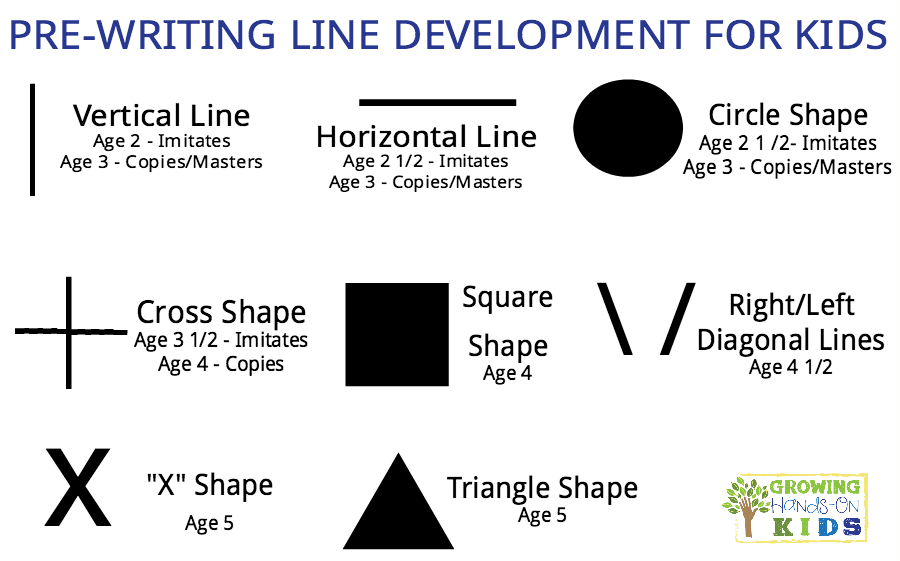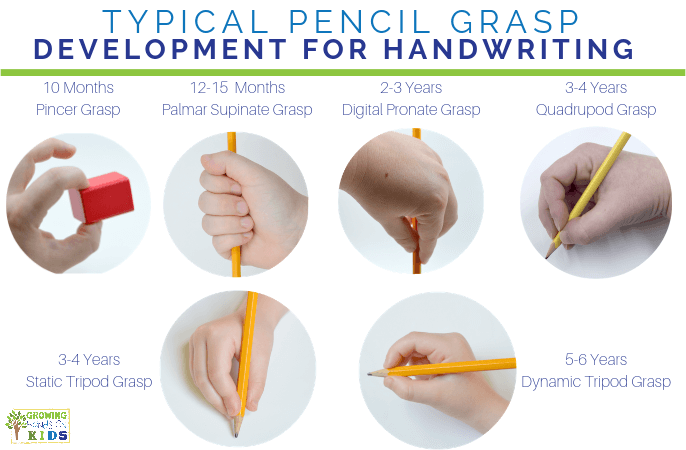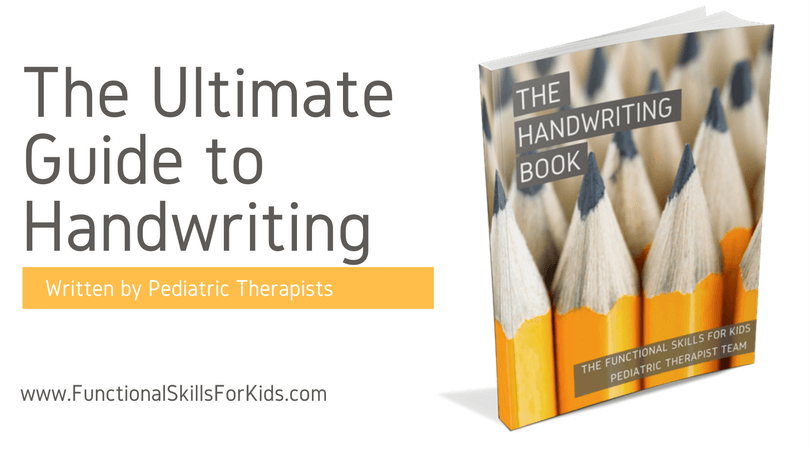When Should I Teach My Child to Write?
Affiliate and Referral links are used below to promote products I love and recommend. I receive a commission on any purchases made through these links. Please see my disclosure policy for more details. As an Amazon Associate, I earn from qualifying purchases.
Along with learning to read, writing is another significant milestone that parents often wonder about. One question I see over and over again is “when should I teach my child to write?”
The answer is not cut and dry, “they should know how to write by age ‘insert age here'”. Writing, or handwriting, is a very complex milestone that involves many building blocks of skills that you may not realize.
So let's take a look at some of these and answer the question, “When should I teach my child how to write?
Skills Needed for Handwriting
If you are looking for a specific age for when to introduce handwriting, unfortunately, I can't really give you one. What I can do is show you developmentally what is appropriate based on your child's current age.
However, even with this, it is still important to remember that each child is different. Not only do we want to consider what is age-appropriate, but developmentally what is appropriate for your child and what their interest level is.
There are some foundational skills, or building blocks, that a child needs in order to be successful with handwriting.
These include:
Sensory Processing – specifically proprioception, or the ability to know where their body is in space. This affects pencil grasp, being able to put enough pressure on the pencil to write without looking at it, and also affects posture (slouching vs. sitting upright).
You can learn more about proprioception here.
Gross motor skills – this includes being able to cross the midline (with the hands as well as the eyes), bilateral coordination (holding the paper down with one hand while writing with the other), and core strength (being able to sit upright and not slouching).
Fine motor skills – I wrote specifically on the fine motor skills needed for handwriting here, but I'll give you the shortened version for this post. Fine motor skills involve a lot of different skills, but it is thought that in-hand manipulation has a significant effect on handwriting. This relates to pencil grasp as well.
You can read more on pencil grasp development here.
And also I shared some activities for in-hand manipulation here.
Visual-motor skills – You may see a lot of confusing terms related to visual-motor skills. Visual motor skills involve the physical movements of the eye as well as interpreting information the eyes receive by the brain. Eye-hand coordination is the skill that takes the information from the eyes and is able to coordinate movement of the hands with the eyes.
When all of this information is working together, you have what is called visual-motor integration. This means that the eyes and motor movements (visual perception and motor skills) are working together in order to complete tasks.
A child needs eye-hand coordination, visual perception, and spatial perception, to name a few, in order to be successful with handwriting.
Executive Function – As your child grows, they will use more executive function skills with their writing. Executive function includes working memory, planning and completing tasks, and organization. You can read more about executive function here.
Handwriting Milestones
Now that we know what skills are needed for handwriting, let's look at typical handwriting milestones.
Pre-writing skills are a huge part of handwriting, so you will see me reference these throughout these milestones. I'll give you links to further reading on this term at the end of this section.
Toddlers (15-24 months old) – Toddlers are beginning to scribble and make marks on a page with a fisted grasp.
Preschool (3-4 years old) – Start to make marks and lines that resemble objects (drawing), can begin to master some pre-writing lines (vertical, horizontal, and circle shapes as an example). May write some letters of the alphabet, typically the ones in their name. Pencil grasp is still developing.
Kindergarten (5-6 years old) – Pencil grasp is maturing to a dynamic tripod or quadrupod grasp. They will also be learning how to write all the letters of the alphabet and some numbers.
This is where we need to remember that mastering pre-writing lines should come first. If a child has not mastered some of those lines or shapes, writing the alphabet may be harder for them. Some children may start spelling small words by sound.
Early Elementary (6-8 years old) – Start being able to spell and write words such as sight words and short sentences. By the end of 2nd grade, a child may be able to write a page-long narrative or opinion piece of writing.
Elementary (8-10 years old) – Write more complex sentences and start learning how to self-edit their work. They also start to understand the process of planning, drafting, and revising their written work. Many children also begin typing on a keyboard at this age for longer written assignments.
Middle School (10-13 years old) – Continue to develop typing skills, grammar, spelling, and vocabulary knowledge.
High School (14 years and older) – Write longer and more complex papers on a variety of topics. Also how to combine information from multiple sources.
Here are more resources as I promised above:
- Typical Fine Motor Developmental Milestones
- Typical Visual-Motor Developmental Milestones
- Basics of Pre-Writing Skills & Activities
- Writing Skills: What To Expect at Different Ages – Understood.org
- Written Communication Development Chart – ChildDevelopment.com.au
When Should I Teach My Child to Write?
Many people start to ask this question when their child enters preschool. However, as we've been looking at above, many preschool-age children are not ready for formal handwriting instruction simply because they are not developmentally ready.
However, if a child is showing interest in writing we should follow their lead. If you have a younger child who wants to learn to write their name, then by all means start showing them.
What I do want to stress is that we remember what is developmentally appropriate and realize that mastery of these skills may not come for a few months or even years.
Focusing on those foundational skills for handwriting, especially at these younger ages, will set your child up for a successful handwriting experience.
My Personal Experience As a Homeschool-Mom
Let me share what I have done personally with my children.
My daughter, who is the oldest, was never really interested in drawing, coloring, or writing. Even when we hit Kindergarten, she really disliked it. I continued to provide ways for her to practice, while also focusing on fine motor and other skills that I knew she needed.
When first grade came, she suddenly wanted to color all the time and quickly picked up on it. She is now is 2nd grade and loves to draw, is starting to spell and we finally found a handwriting curriculum that she loves to use (it is from The Good and the Beautiful found here).
My son, who is 5, began Pre-K this year and we are also using The Good and The Beautiful with him. Before this, we focused on a lot of fine motor skills, visual-motor, gross motor, etc., and still continue to do that.
One day he asked me to show him how to write his first and last time and after about a week of practice, he was able to do it in all uppercase letters. This was something I monitored, but it was mostly interest-led for him.
We will continue to focus more on this in Kindergarten next year when he will be 6.
If you'd like more information on handwriting, I would love for you to check out The Handwriting Book. It was written by myself and 10 other pediatric Occupational Therapists and Physical Therapists and will be a great resource as you navigate handwriting.

Heather Greutman, COTA
Heather Greutman is a Certified Occupational Therapy Assistant with experience in school-based OT services for preschool through high school. She uses her background to share child development tips, tools, and strategies for parents, educators, and therapists. She is the author of many ebooks including The Basics of Fine Motor Skills, and Basics of Pre-Writing Skills, and co-author of Sensory Processing Explained: A Handbook for Parents and Educators.





I am wondering if you have this article in Spanish?
Hi Teresa,
Thanks for the suggestion. I just added a translate button to the right side of my website so you can change the article into Spanish right on the site. I hope that helps.